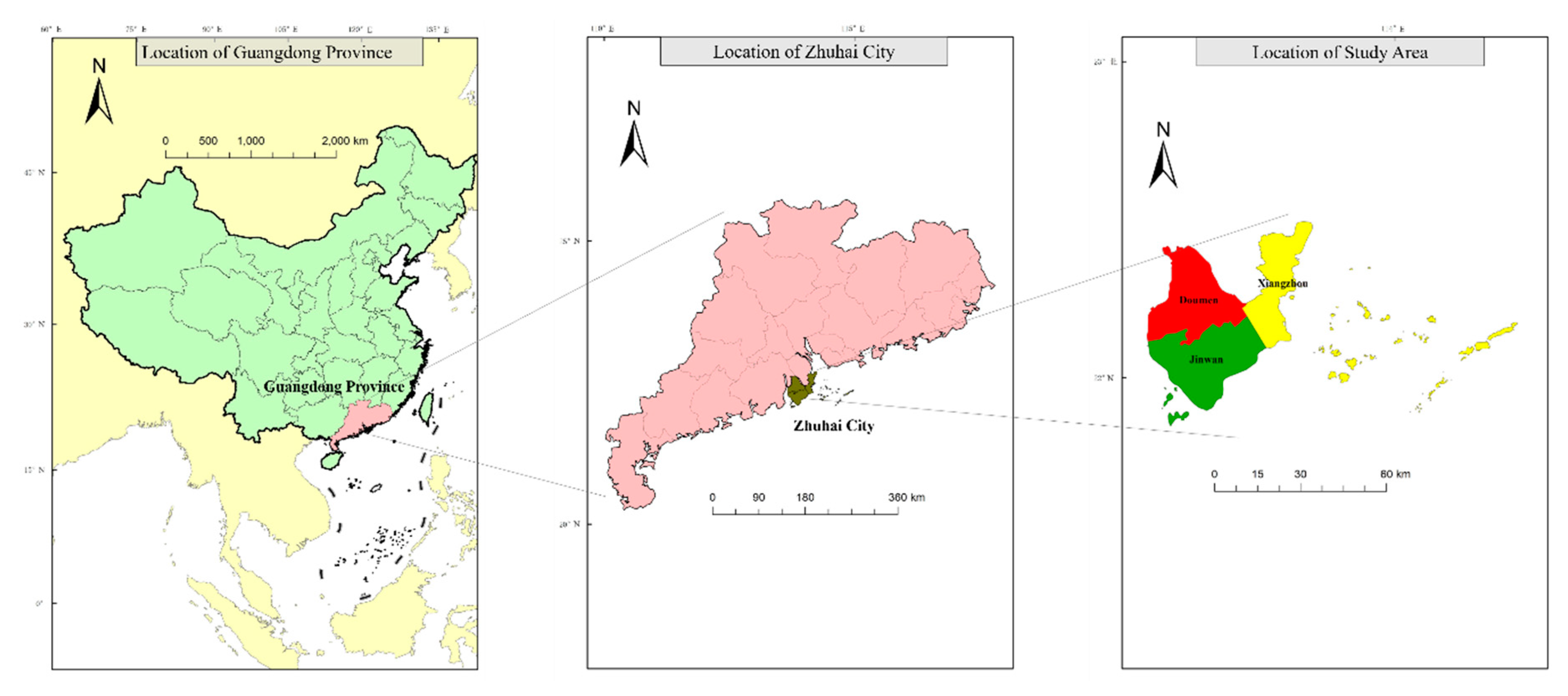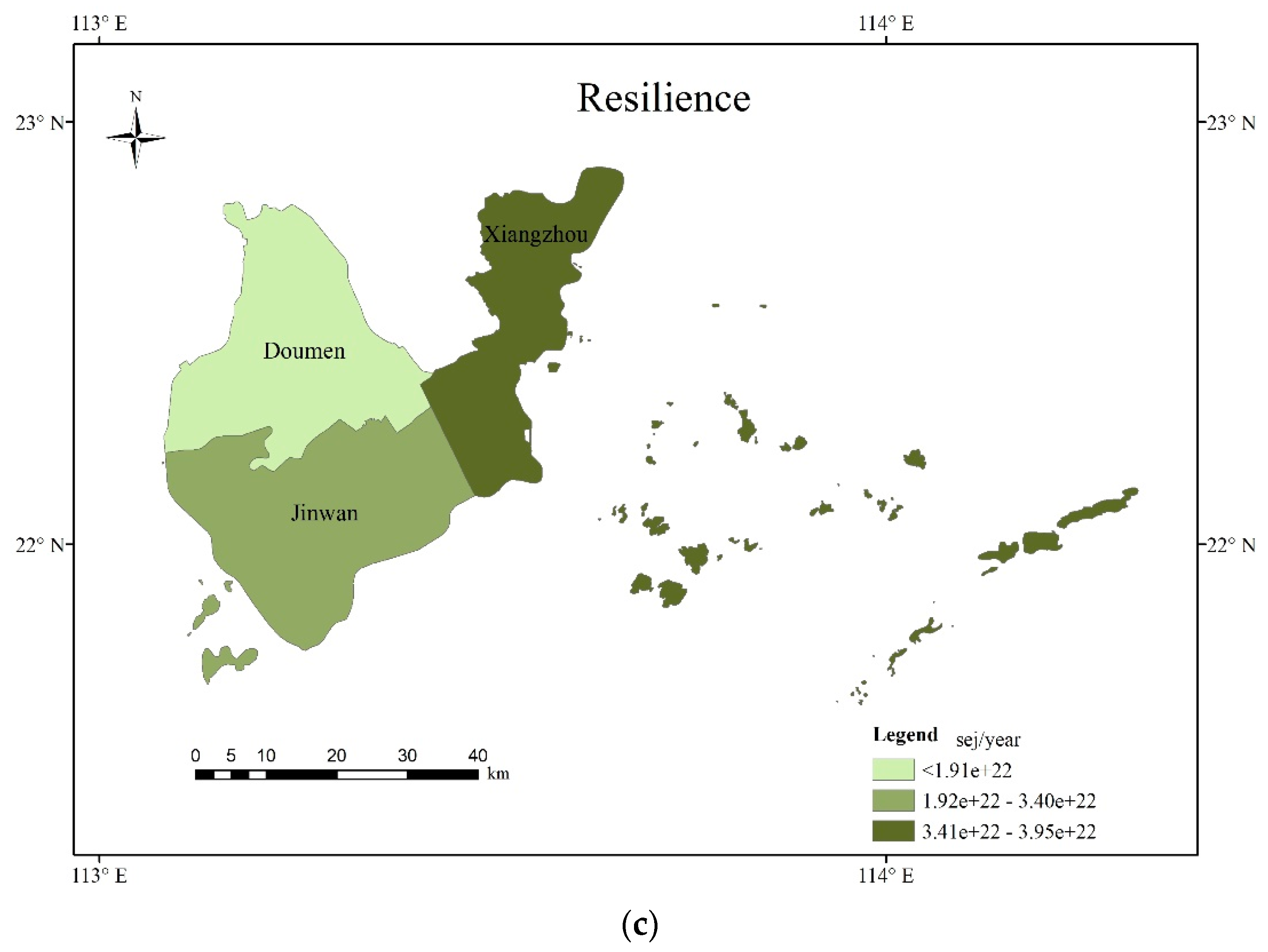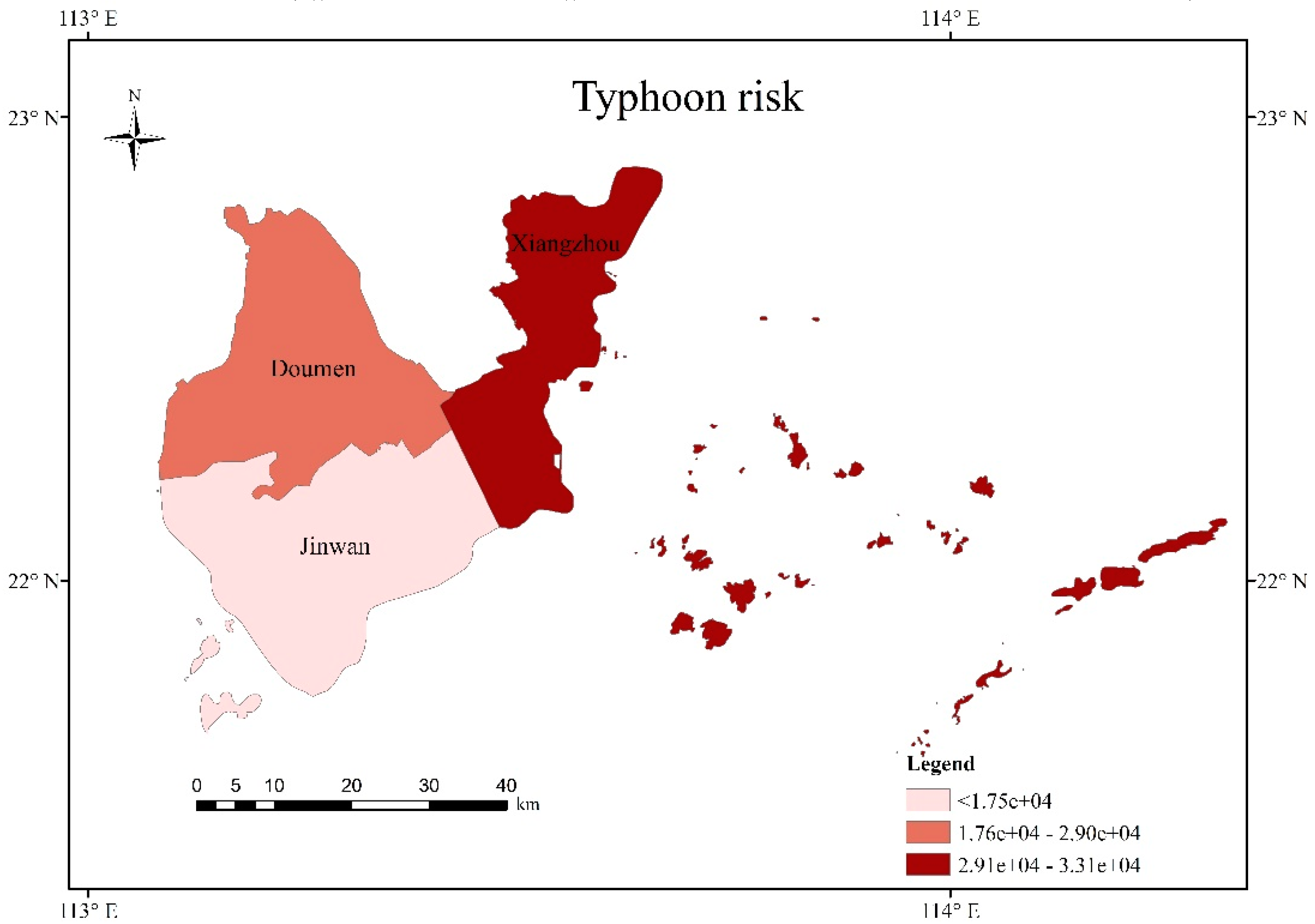Typhoon Disaster Risk Assessment Based on Emergy Theory: A Case Study of Zhuhai City, Guangdong Province, China
Abstract
1. Introduction
2. Data and Methodology
2.1. Study Site
2.2. Data Collection
2.3. Emergy Theoretical Basis for Risk Assessment
2.3.1. The Emergy Accounting Method (EMA)
2.3.2. Typhoon Disaster Energy System Diagram
2.3.3. Typhoon Disaster Risk Assessment Model
2.3.4. Typhoon Total Driving Emergy
2.3.5. Sensitivity Index
2.3.6. Typhoon Strength Effectiveness
2.3.7. Resilience
2.3.8. Typhoon Risk Comprehensive Index
3. Results
- The total driving emergy represented the total cumulative emergy during 2017. The more energy a region stores over a period, the larger the total driving emergy. Table 2 and Figure 4 show that among the three districts of Zhuhai, Xiangzhou district had the largest total driving emergy value, and Doumen district had the smallest. This was because the typhoon centers of the three typhoons that passed through Zhuhai in 2017 moved from the southeast to the northwest. The Xiangzhou district was closest to the typhoon center, and the Doumen district was the farthest away from the center. In addition, when the typhoon landed, due to the influence of the topography of the underlying surface, the wind force of the typhoon weakened, and thus the total driving emergy value in the Doumen area was the smallest.
- The concept of energy level is used to analyze the sensitivity of the research area to typhoons. On the basis of the empower density of land use, we calculated the emergy content of different land use types in each district of Zhuhai. Areas with a high ratio of total emergy to unused land emergy (such as residential areas and commercial areas) have high sensitivity, and they were likely to suffer greater losses from typhoon disasters. The calculation results showed that compared with that of the other two districts, the sensitivity of Xiangzhou district was extremely high. This was because Xiangzhou district has a large population and is also a place where residential and commercial areas are very concentrated. In contrast, this area had a high sensitivity index because it has a minimal amount of unused land
- The purpose of the adaptive capacity assessment was to understand the ability of the affected area to respond to typhoons. Xiangzhou district has a developed economy, medical facilities, and a highly educated population, and thus its resilience value was found to be high. In comparison to the other districts, Doumen district has more arable land, the ecosystem is more fragile, and its economic level is relatively undeveloped, so its resilience value was found to be low.
- The typhoon strength effectiveness was related to the total driving emergy and sensitivity, which indicated that the system may suffer when an extreme weather event occurs. Due to the dense population of Xiangzhou district, rapid economic development and accumulated assets, the typhoon strength effectiveness was higher there than the other areas when typhoons occurred. In contrast, areas with relatively slow population development, such as in Doumen district, had a lower total driving emergy index.
- The typhoon risk comprehensive index was related to the typhoon strength effectiveness and resilience. The greater the typhoon risk comprehensive index in a certain area is, the higher the risk of typhoon disaster. For this index, Figure 5 shows that Xiangzhou district had the highest value, Doumen district had the second highest value, and Jinwan district had the lowest value, which was significantly lower than the first two values. The resilience of Xiangzhou district was the highest among the three districts, but because of the high concentration of population and wealth, the value of the typhoon strength effectiveness was also much higher than that of the two districts; thus, the value of the typhoon risk comprehensive index was the largest. In addition, although the value of the total driving emergy index of the Doumen district was low, its resilience was also the weakest of the three areas, and thus it has a higher risk. As shown in Table 2, the emergy of the direct economic loss due to the typhoon disasters in the three regions is consistent with the results of the typhoon risk comprehensive index obtained in this study.
4. Discussion
5. Conclusions
Author Contributions
Funding
Conflicts of Interest
References
- Gurgel, C.F.D.; Camacho, O.; Minne, A.J.P.; Wernberg, T.; Coleman, M.A. Marine Heatwave Drives Cryptic Loss of Genetic Diversity in Underwater Forests. Curr. Biol. 2020, 30, 1199–1206.e2. [Google Scholar] [CrossRef] [PubMed]
- Paul, S.; Ghebreyesus, D.; Sharif, H. Brief Communication: Analysis of the Fatalities and Socio-Economic Impacts Caused by Hurricane Florence. Geosciences 2019, 9, 58. [Google Scholar] [CrossRef]
- Zhang, Y.; Fan, G.; He, Y.; Cao, L. Risk assessment of typhoon disaster for the Yangtze River Delta of China. Geomat. Nat. Hazards Risk 2017, 8, 1580–1591. [Google Scholar] [CrossRef]
- Kim, J.; Son, K.; Kim, Y. Assessing regional typhoon risk of disaster management by clustering typhoon paths. Environ. Dev. Sustain. 2019, 21, 2083–2096. [Google Scholar] [CrossRef]
- Wang, H.; Xu, M.; Onyejuruwa, A.; Wang, Y.; Wen, S.; Gao, A.E.; Li, Y. Tropical cyclone damages in Mainland China over 2005–2016: Losses analysis and implications. Environ. Dev. Sustain. 2019, 21. [Google Scholar] [CrossRef]
- Chen, X.; Wu, L.; Zhang, J. Increasing duration of tropical cyclones over China. Geophys. Res. Lett. 2011, 38. [Google Scholar] [CrossRef]
- Li, M.; Wu, W.; Wang, J.; Che, Z.; Xie, Y. Simulating and mapping the risk of surge floods in multiple typhoon scenarios: A case study of Yuhuan County, Zhejiang Province, China. Stoch. Environ. Res. Risk A 2017, 31, 645–659. [Google Scholar] [CrossRef]
- Wang, Y.; Wen, S.; Li, X.; Thomas, F.; Su, B.; Wang, R.; Jiang, T. Spatiotemporal distributions of influential tropical cyclones and associated economic losses in China in 1984–2015. Nat. Hazards 2016, 84, 2009–2030. [Google Scholar] [CrossRef]
- Katsube, K.; Inatsu, M. Response of Tropical Cyclone Tracks to Sea Surface Temperature in the Western North Pacific. J. Clim. 2016, 29, 1955–1975. [Google Scholar] [CrossRef]
- DeMaria, M. The effect of vertical shear on tropical cyclone intensity change. J. Atmos. Sci. 1996, 53, 2076–2087. [Google Scholar] [CrossRef]
- Dorland, C.; Tol, R.; Palutikof, J.P. Vulnerability of the Netherlands and Northwest Europe to storm damage under climate change—A model approach based on storm damage in the Netherlands. Clim. Chang. 1999, 43, 513–535. [Google Scholar] [CrossRef]
- Nam, C.C.; Park, D.R.; Ho, C.; Chen, D. Dependency of tropical cyclone risk on track in South Korea. Nat. Hazard Earth Syst. 2018, 18, 3225–3234. [Google Scholar] [CrossRef]
- Zheng, Y.; Shao, G.; Tang, L.; He, Y.; Wang, X.; Wang, Y.; Wang, H. Rapid Assessment of a Typhoon Disaster Based on NPP-VIIRS DNB Daily Data: The Case of an Urban Agglomeration along Western Taiwan Straits, China. Remote Sens. Basel 2019, 11, 1709. [Google Scholar] [CrossRef]
- Lu, Y.; Ren, F.; Zhu, W. Risk zoning of typhoon disasters in Zhejiang Province, China. Nat. Hazard Earth Syst. 2018, 18, 2921–2932. [Google Scholar] [CrossRef]
- Song, J.; Huang, B.; Li, R. Assessing local resilience to typhoon disasters: A case study in Nansha, Guangzhou. PLoS ONE 2018, 13, e190701. [Google Scholar] [CrossRef] [PubMed]
- Hall, B.J.; Xiong, Y.X.; Yip, P.S.Y.; Lao, C.K.; Shi, W.; Sou, E.K.L.; Chang, K.; Wang, L.; Lam, A.I.F. The association between disaster exposure and media use on post-traumatic stress disorder following Typhoon Hato in Macao, China. Eur. J. Psychotraumatology 2019, 10, 1558709. [Google Scholar] [CrossRef] [PubMed]
- Wu, D.; Huang, M.; Zhang, Y.; Bhatti, U.A.; Chen, Q. Strategy for assessment of disaster risk using typhoon hazards modeling based on chlorophyll-a content of seawater. Eurasip J. Wirel Comm. 2018, 2018. [Google Scholar] [CrossRef]
- Odum, H.T. Environmental Accounting: EMERGY and Environmental Decision Making; Wiley: Hoboken, NJ, USA, 1996; p. 370. [Google Scholar]
- Lu, H.; Xu, F.; Liu, H.; Wang, J.; Campbell, D.E.; Ren, H. Emergy-based analysis of the energy security of China. Energy 2019, 181, 123–135. [Google Scholar] [CrossRef]
- Zhou, Y.; Shan, Y.; Liu, G.; Guan, D. Emissions and low-carbon development in Guangdong-Hong Kong-Macao Greater Bay Area cities and their surroundings. Appl. Energy 2018, 228, 1683–1692. [Google Scholar] [CrossRef]
- Chuan-xin, Q.; Pi-mao, C.; An-kai, Z.; Hua-rong, Y.; Guo-ying, L.I.; Li-ming, S.; Yan-Bo, Z.; Xiao-guo, L.I. Evaluation of ecosystem service and emergy of Wanshan Waters in Zhuhai, Guangdong Province, China. Yingyong Shengtai Xuebao 2015, 26, 1847–1853. [Google Scholar]
- Ye, M.; Wu, J.; Wang, C.; He, X. Historical and Future Changes in Asset Value and GDP in Areas Exposed to Tropical Cyclones in China. Weather Clim. Soc. 2019, 11, 307–319. [Google Scholar] [CrossRef]
- China Meteorological Observatory Website. Available online: http://typhoon.nmc.cn/web.html (accessed on 18 April 2020).
- Zhuhai Municipal Bureau of Statistics. Available online: http://www.stats-zh.gov.cn/ (accessed on 18 April 2020).
- Huang, S.; Lai, H.; Lee, C. Energy hierarchy and urban landscape system. Landsc. Urban Plan 2001, 53, 145–161. [Google Scholar] [CrossRef]
- Zhai, M.; Huang, G.; Liu, L.; Su, S. Dynamic input-output analysis for energy metabolism system in the Province of Guangdong, China. J. Clean. Prod. 2018, 196, 747–762. [Google Scholar] [CrossRef]
- Bank of China. Available online: http://www.boc.cn/ (accessed on 18 April 2020).
- Brown, M.T.; Campbell, D.E.; De Vilbiss, C.; Ulgiati, S. The geobiosphere emergy baseline: A synthesis. Ecol. Model. 2016, 339, 92–95. [Google Scholar] [CrossRef]
- Brown, M.T.; Ulgiati, S. Updated evaluation of exergy and emergy driving the geobiosphere: A review and refinement of the emergy baseline. Ecol. Model. 2010, 221, 2501–2508. [Google Scholar] [CrossRef]
- Huang, S. Urban ecosystems, energetic hierarchies, and ecological economics of Taipei metropolis. J. Environ. Manag. 1998, 52, 39–51. [Google Scholar] [CrossRef]
- Su, M.; Yang, Z.; Chen, B. Limiting factor analysis of urban ecosystems based on emergy—A case study of three cities in the Pearl River Delta in China. Procedia Environ. Sci. 2011, 5, 131–138. [Google Scholar] [CrossRef]
- Peijun, S.; Du, J.; Mengxin, J.; Jing, L.; Jingai, W. Urban Risk Assessment Research of Major Natural Disasters in China. Adv. Earth Sci. 2006, 21, 170–177. [Google Scholar]
- Brown, M.T.; Ulgiati, S. Assessing the global environmental sources driving the geobiosphere: A revised emergy baseline. Ecol. Model. 2016, 339, 126–132. [Google Scholar] [CrossRef]
- Ghisellini, P.; Cialani, C.; Ulgiati, S. A review on circular economy: The expected transition to a balanced interplay of environmental and economic systems. J. Clean. Prod. 2016, 114, 11–32. [Google Scholar] [CrossRef]
- Yang, L.; Cao, C.; Wu, D.; Qiu, H.; Lu, M.; Liu, L. Study on Typhoon Disaster Loss and Risk Prediction and Benefit Assessment of Disaster Prevention and Mitigation. Trop. Cyclone Res. Rev. 2018, 7, 237–246. [Google Scholar]
- Jiansheng, W.; Yuhao, Z.; Tian, Y.; Bikai, C. Evolution of typhoon disasters characteristics and non-structural disaster avoidance measures in the China coastal main functional area. Int. J. Disast. Risk Reduct. 2020, 46, 101490. [Google Scholar] [CrossRef]
- Wang, N.; Hou, Y.; Li, S.; Li, R. Numerical simulation and preliminary analysis of typhoon waves during three typhoons in the Yellow Sea and East China Sea. J. Oceanol. Limnol. 2019, 37, 1805–1816. [Google Scholar] [CrossRef]
- García-Ayllón, S.; Tomás, A.; Ródenas, J.L. The Spatial Perspective in Post-Earthquake Evaluation to Improve Mitigation Strategies: Geostatistical Analysis of the Seismic Damage Applied to a Real Case Study. Appl. Sci. 2019, 9, 3182. [Google Scholar] [CrossRef]






| Indicators | Interpretation | Unit |
|---|---|---|
| Total driving emergy | Typhoon energy × Solar transformity | sej |
| Sensitivity index | (Different land use area × empower density)/(unused land area × empower density) 1 | - |
| Typhoon strength effectiveness | Total driving emergy × Sensitivity index | sej |
| Resilience | Medical staff per 10,000 people × Solar transformity | sej |
| College students per 10,000 people × Solar transformity | sej | |
| Shelterbelt area × Solar transformity | sej | |
| Foundation protection weight × Solar transformity | sej | |
| GDP × Solar transformity | sej | |
| Fixed asset investment × Solar transformity | sej | |
| Typhoon risk comprehensive index | Typhoon strength effectiveness/Resilience | - |
| Item 1 | District | ||
|---|---|---|---|
| Xiangzhou | Doumen | Jinwan | |
| Typhoon transit time/hour | 35 | 30 | 31 |
| Total driving emergy2/1022sej | 1.56 | 1.33 | 1.38 |
| Cultivated land area/107m2 | 0.53 | 9.47 | 7.60 |
| Emergy of cultivated land/1021 sej | 0.65 | 11.64 | 9.35 |
| Forestland land area/107m2 | 15.93 | 10.67 | 11.00 |
| Emergy of forestland/1021 sej | 9.63 | 6.44 | 6.64 |
| Residential land area/107m2 | 17.47 | 11.20 | 12.60 |
| Emergy of residential land/1025 sej | 10.12 | 6.49 | 7.30 |
| Traffic land area/107m2 | 1.66 | 1.60 | 2.13 |
| Emergy of traffic land/1024 sej | 4.73 | 4.54 | 6.05 |
| Unused land area/107m2 | 11.73 | 23.13 | 18.33 |
| Emergy of unused land/1020 sej | 1.23 | 2.43 | 1.93 |
| Sensitivity index3/105 | 8.40 | 4.15 | 4.32 |
| Typhoon strength effectiveness4/1027sej | 13.11 | 5.55 | 5.97 |
| Medical staff per 10,000 people/person | 52.08 | 36.22 | 25.71 |
| Emergy/1021 sej | 0.70 | 0.49 | 0.34 |
| College students per 10,000 people/person | 1642.01 | 890.94 | 369.89 |
| Emergy/1021 sej | 3.84 | 2.08 | 0.87 |
| Fixed asset investment/billion USD | 100.02 | 21.55 | 44.63 |
| Emergy/1022 sej | 6.42 | 1.38 | 2.87 |
| GDP/billion USD | 175.64 | 35.60 | 56.27 |
| Emergy/1022 sej | 11.28 | 2.29 | 3.61 |
| Resilience emergy5/1022 sej | 3.95 | 1.91 | 3.40 |
| Agricultural emergy loss/1021 sej | 4.35 | 1.49 | 1.24 |
| Mining and business emergy loss/1021 sej | 2.37 | 0.43 | 0.61 |
| Infrastructure emergy loss/1019 sej | 306.14 | 0.19 | 8.47 |
| Public facility emergy loss/1019 sej | 89.33 | 0.19 | 8.86 |
| Property emergy loss/1020 sej | 10.26 | 0.51 | 0.73 |
| Direct economic emergy loss /1021 sej | 5.51 | 4.28 | 3.60 |
| Typhoon risk comprehensive index6/105 | 3.31 | 2.90 | 1.75 |
© 2020 by the authors. Licensee MDPI, Basel, Switzerland. This article is an open access article distributed under the terms and conditions of the Creative Commons Attribution (CC BY) license (http://creativecommons.org/licenses/by/4.0/).
Share and Cite
Gao, Z.; Wan, R.; Ye, Q.; Fan, W.; Guo, S.; Ulgiati, S.; Dong, X. Typhoon Disaster Risk Assessment Based on Emergy Theory: A Case Study of Zhuhai City, Guangdong Province, China. Sustainability 2020, 12, 4212. https://doi.org/10.3390/su12104212
Gao Z, Wan R, Ye Q, Fan W, Guo S, Ulgiati S, Dong X. Typhoon Disaster Risk Assessment Based on Emergy Theory: A Case Study of Zhuhai City, Guangdong Province, China. Sustainability. 2020; 12(10):4212. https://doi.org/10.3390/su12104212
Chicago/Turabian StyleGao, Zhicheng, Rongjin Wan, Qian Ye, Weiguo Fan, Shihui Guo, Sergio Ulgiati, and Xiaobin Dong. 2020. "Typhoon Disaster Risk Assessment Based on Emergy Theory: A Case Study of Zhuhai City, Guangdong Province, China" Sustainability 12, no. 10: 4212. https://doi.org/10.3390/su12104212
APA StyleGao, Z., Wan, R., Ye, Q., Fan, W., Guo, S., Ulgiati, S., & Dong, X. (2020). Typhoon Disaster Risk Assessment Based on Emergy Theory: A Case Study of Zhuhai City, Guangdong Province, China. Sustainability, 12(10), 4212. https://doi.org/10.3390/su12104212







